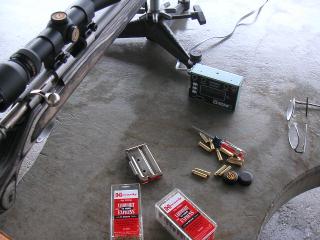
I got to thinking about how I rarely shoot rimfire rifles anymore. While indoor ranges are plentiful, making rimfire rifles a good bet for convenient marksmanship practice, I’d really rather be outdoors shooting. Of course, once outside, and no longer restricted to rimfire, I’d have little cause to shoot them. The point is, for as much as I like the concept of cheap ammo and guns, my rimfire rifles are mostly dust collectors, awaiting opportunities to provide firearms education to grandchildren and other new shooters.
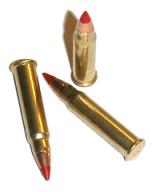 For a while, I thought I might like constructing a specialized gun based on the Ruger 10/22. However, after review, this seemed potentially a very costly project, that would yield a very limited application firearm. I thought a little bigger cartridge like a .22 Winchester Magnum might be a little less boring, I have owned a couple of firearms chambered for this cartridge, but they didn’t seem very accurate, and the ammo was expensive in light of the marginal improvement in performance over the hyper velocity .22 LR products. I really liked the concept of the 5MM Remington, but sometime between the morning of its introduction, and my afternoon arrival at a gun store, it apparently went obsolete. When the Hornady‘s .17 HMR was announced, and the product seemed to take legs, I followed the news and subsequent developments with interest.
For a while, I thought I might like constructing a specialized gun based on the Ruger 10/22. However, after review, this seemed potentially a very costly project, that would yield a very limited application firearm. I thought a little bigger cartridge like a .22 Winchester Magnum might be a little less boring, I have owned a couple of firearms chambered for this cartridge, but they didn’t seem very accurate, and the ammo was expensive in light of the marginal improvement in performance over the hyper velocity .22 LR products. I really liked the concept of the 5MM Remington, but sometime between the morning of its introduction, and my afternoon arrival at a gun store, it apparently went obsolete. When the Hornady‘s .17 HMR was announced, and the product seemed to take legs, I followed the news and subsequent developments with interest.
I’m not going to cover the cartridge in detail, this has been done in many other places right down to full reports of early manufacturing delays, CCI’s production participation, the use of Hodgdon Lil’ Gun powder, etc, etc. I don’t believe any of that matters, other than in a distant future game of “Cartridge Trivial Pursuit”. Briefly, the .17 HMR is loaded with a 17 grain Hornady VMAX poly tipped and jacketed bullet, and the case approximates a .22 Winchester Magnum, necked down to .17 caliber. The Hornady box carries the notation “2550 fps”, however, I do not know what configuration of firearm this reflects, or under what circumstances the velocity was recorded. The 17 Hornady Magnum Rimfire is designed to shred small critters which, I suspect, it could do handily. When the number of rifle models chambered for the cartridge passed 10, and the number of manufacturers producing these models exceeded 7, even I knew it was time to jump on the proverbial .17 HMR band wagon.
Marlin 17 VS
 It was my positive experience with Marlin’s 1885 Guide Gun, that caused me to take a good look at their 17 VS. Both gun’s are quite a departure from Marlin’s much earlier, more pedestrian, utility grade products.
It was my positive experience with Marlin’s 1885 Guide Gun, that caused me to take a good look at their 17 VS. Both gun’s are quite a departure from Marlin’s much earlier, more pedestrian, utility grade products. The gun’s trigger pull, as received, but after general cleaning was 4 1/2 lbs and crisp. The overall length of the gun is about 41 1/4″, the stock pull is a comfortable 13 3/4″, the forearm bottom is formed flat, about 1 1/2″ wide. The heavy 22″ barrel has a 1:9 twist, and four groove rifling, rather than Marlin proprietary Micro-Groove® rifling. The barrel has a target crown with a .815″ muzzle. The gun does not have metallic sights, however, the receiver has a 3/8″ groove to accommodate scope mounts. With scope in place, the gun’s CG is right at the union of the barrel and receiver, making the gun very easy to hold steady on target from an offhand position.
The gun’s trigger pull, as received, but after general cleaning was 4 1/2 lbs and crisp. The overall length of the gun is about 41 1/4″, the stock pull is a comfortable 13 3/4″, the forearm bottom is formed flat, about 1 1/2″ wide. The heavy 22″ barrel has a 1:9 twist, and four groove rifling, rather than Marlin proprietary Micro-Groove® rifling. The barrel has a target crown with a .815″ muzzle. The gun does not have metallic sights, however, the receiver has a 3/8″ groove to accommodate scope mounts. With scope in place, the gun’s CG is right at the union of the barrel and receiver, making the gun very easy to hold steady on target from an offhand position.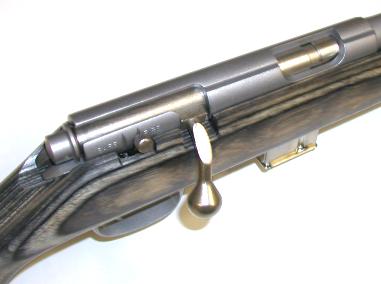
Parts of the gun are stainless steel; barrel, receiver, front breech bolt, striker knob, and trigger stud. Some parts are nickel plated carbon steel; bolt handle, clip and sling swivels. The trigger guard is a silver finished cast alloy part, as is the trigger. The stock is a nicely finished hardwood gray/black laminate, capped with a non-slip recoil pad.
The gun’s fit and finish is excellent; not a scratch, rough edge or blemish anywhere, which is a departure from most everything I have recently purchase. Nice to see this quality from Marlin.
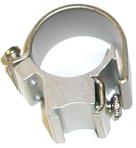

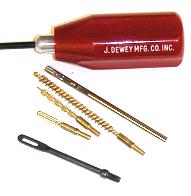
I thought I was all set, when I remembered you can never shoot a new caliber gun without incurring some peripheral expenses. In this case: a Dewey Mfg. Nylon coated cleaning rod, a jag, a patch loop and a bronze brush. It’s hard to envision how small a .17 bore is until you put a patch loop down next to a .22 LR loop (bottom), or buy an air rifle, which ever comes first. These small accessories may be a little hard to locate, but Brownells had them in stock and shipped them the same day they were ordered.Fortunately, my old Simmons Boresight kit included a .17 cal stud. The scope, with H/V adjusted to mid range, was initially positioned a little higher than I liked, but not seriously out of adjustment range center.
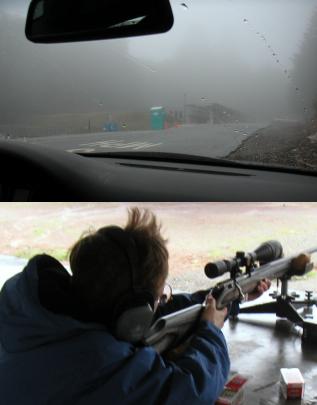 Lately, I haven’t had free time to spend on a near 3 hours round trip to the usual range, so I tried the “Where to Shoot” web site, and located several alternative area ranges. Based on their informative web site, the expansive services offered, and the courtesy and expediency of responding to e-mail, I decided to try Los Altos Rod and Gun Club. As the view through the windshield suggests, we might have picked a better day to try a new facility, but they had a full staff and all services were available, so….I believe my wife’s vertical hairdo worked well as an accurate indicator of wind velocity. However, while she was able to report 10 knots and gusting, she did not share my appreciation for this good fortune, and demonstrated her sentiments by shooting consistently better groups. Diane was comfortable with the rifle, although the stock pull was a bit long and her cold weather bulky coat kept getting in the way. Session punctuating periods of near horizontal rain led to conversations regarding a design for eyeglass windshield wipers.
Lately, I haven’t had free time to spend on a near 3 hours round trip to the usual range, so I tried the “Where to Shoot” web site, and located several alternative area ranges. Based on their informative web site, the expansive services offered, and the courtesy and expediency of responding to e-mail, I decided to try Los Altos Rod and Gun Club. As the view through the windshield suggests, we might have picked a better day to try a new facility, but they had a full staff and all services were available, so….I believe my wife’s vertical hairdo worked well as an accurate indicator of wind velocity. However, while she was able to report 10 knots and gusting, she did not share my appreciation for this good fortune, and demonstrated her sentiments by shooting consistently better groups. Diane was comfortable with the rifle, although the stock pull was a bit long and her cold weather bulky coat kept getting in the way. Session punctuating periods of near horizontal rain led to conversations regarding a design for eyeglass windshield wipers.

This made setting up a chronograph, scheduling shooting sequences and changing targets easy for a change without the typical 15 minute shooting increments, followed by a group cease fire for target changes .
Los Altos did a great job on field drainage as, even in this miserable weather, there was no sloshing around when changing targets, or 20 lbs of mud on boots. The cement firing line pad extended far enough forward to place the chronograph tripod on the hard level surface.
| First 16 shots – FPS | |||||
| 1 | 2557 | 6 | 2564 | 11 | 2594 |
| 2 | 2565 | 7 | 2584 | 12 | 2594 |
| 3 | 2569 | 8 | 2579 | 13 | 2598 |
| 4 | 2585 | 9 | 2606 | 14 | 2597 |
| 5 | 2587 | 10 | 2598 | 15 | 2602 |

I didn’t waste a lot of time zeroing in, I just wanted to get close and see how the cartridge and rifle would group. The first target, top left, was a 14 shot (2 clips full) 50 yard warm up. The group was under 1/2″, which I thought was pretty good for that little bullet: in gusting winds, with my general lack of target shooting skill, and my lack of familiarization with a new gun. My wife shot the same size group, perhaps a bit smaller, immediately afterward.
The middle target is two 50 yard 5 shot groups, each is less than 3/8″, shot after approximately 25 rounds had passed through the bore. I shot the first, then shifted the gun in the rest a bit and shot the second set. The gun was able to group this well routinely, and barrel temp didn’t seem to matter very much. I actually shot with the forearm on the rest for the first group, and with the barrel laying on the rest with the second group. I don’t believe point of impact moved as a result of pressure on the barrel, but rather me moving the rifle in the rest.
The last target is 5 shots at 100 yards. It is less than half an inch and not very unique in terms of the rifle’s performance. This group was shot after the rifle has seen perhaps 50 rounds. No sign of accuracy or grouping fall off as a result of bore fouling materialized the whole day. For some reason, I thought the little .17 bore would load up with copper and I’d start seeing flyers and tumblers but, as I indicated, this was not the case.

Email Notification